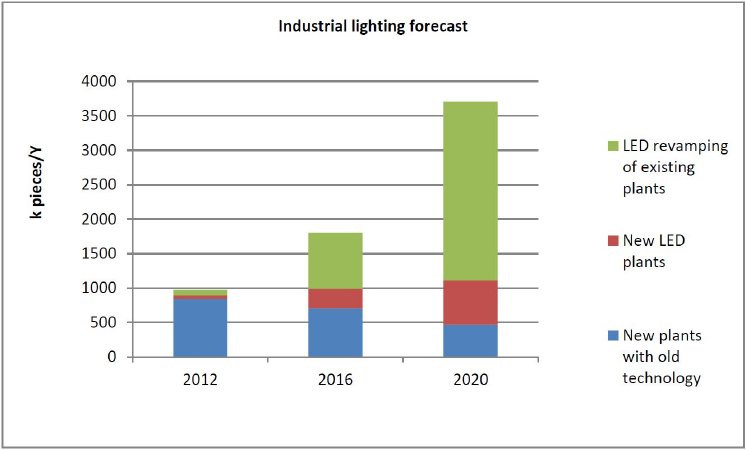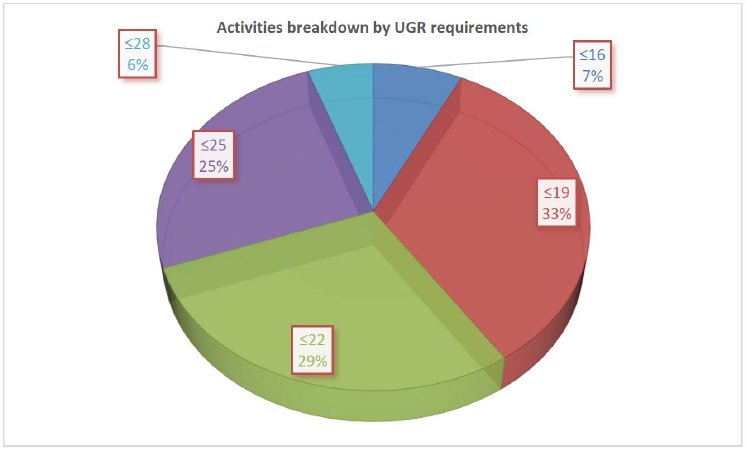The industrial lighting seems to be one of the most attractive application field for the following reasons:
- The SSL penetration is still very low
- The working hours are usually much higher than for other application fields
- There is a big opportunity to enhance the utilization factor in comparison with the technical features of the old technology: above all hot restrike and hemispherical emission
- There is a global opportunity to improve the working areas thanks just to a better lighting plant.
Graph 1: industrial lighting prediction
Pay attention not to reduce the opportunity to a simple comparison between light sources performances, old and new, missing many benefits that will be clear and achievable only for those who will enhance all the value chain for the improvement process.
It is broad that the people are the key factor for this process that can't be independent from how it will be perceived by the final users (meaning the visual task). From this point of view, it's necessary to pay attention to:
- The new technology will be usually perceived as less comfortable than the old one. Moreover a Standard approach has not yet defined which allows to evaluate the effective glare level (UGR) which it's necessary to reach the lighting plant conformity
- The existing plants are globally underlighted not just because the original project was wrong but rather because the lumen maintenance is much lower than that used for the calculation: in some cases also below 35-40%
- From the technical point of view the strong research for economical sustainability and energy saving tends to worsen the quality of light.
Following some rules of experience to make easier the right perception of the new technology benefits and its acceptance.
- Be sure about the conviction of those who will take the final decision considering his needs: focus on energy saving, quality of light, light management, flexibility, best efficiency and so on. When You speak about quality of light You have to mean the improvement over the minimum level defined in accordance with the Standard UNI EN 12464-1 for his specific work activity. The minimum level must be considered not as a performance but as a requirement
- Even if the current Standard can't be considered as suitable to evaluate the right UGR level required in accordance with UNI EN 12464-1, it's anyway true that the fixtures with lower UGR values (calculated in accordance with CIE 177-1995) are perceived as more comfortable. The UGR reduction goes towards a better human centric lighting
- Led samples are much more expensive than in the past with the old technology. Nevertheless, a single installation doesn't give any advantage about the new solution benefits and can transfer a bad impression of the new product that doesn't derive from itself features, but rather by the simultaneous view of different lighting results within an area with the same visual task. Chapter 4.3 from UNI EN 12464-1 can be useful to identify the homogeneous area where to hold the test
- It is helpful to run the test for a time long enough. This approach will avoid the first bad feedback that comes from the continuous fixture view that can be considered normally for the first days. Usually 2 weeks are sufficient to focus on the lighting improvement within the visual task area.
See graph 2: UGR requirements based on UNI EN 12464-1
The focus on quality of light seems stronger looking at activities breakdown by CRI requirements.
See graph 3: CRI requirements based on UNI EN 12464-1
Unfortunately, there is not the same determined approach about colour temperature where only very few activities have a Tc requirement; moreover it is often over 4000K and without any relationship with the circadian effects evaluation [3].
Even if with less hours of exposure the street lighting application field has already started a process of sensitization about the quality of light, sometimes not homogenous but that can be extended also to the industrial lighting in order to improve the revamping process.
Otherwise, there is the risk that this huge opportunity does not include the lighting design knowledge and experience, being too much focused on the energy saving aspects, which are of course the reasons of the opportunity but not the only way to realize it.
[1] Verso un'Italia low carbon: Sistema energetico, occupazione ed investimenti. Executive summary. Rapporto Energia e Ambiente, Scenari e Strategie, ENEA, 2013
[2] Based on Lighting the way: Perspectives on the global lighting market, second edition, McKinsey&Company, 2012
[3] See also the research A proposal of a simplified model to evaluate circadian effects of light sources, L. Bellia and M. Seraceni, Lighting Research and Technology published online 13 June 2013



